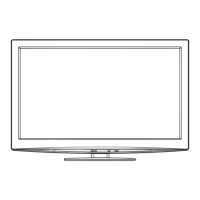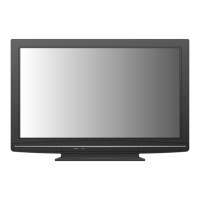Do you have a question about the Panasonic TH-P50VT20D and is the answer not in the manual?
General guidelines for servicing and repairs to ensure safety and correct procedures.
Procedure for checking leakage current between exposed metallic parts and earth ground.
Techniques to reduce component damage from static electricity during handling.
Information on lead-free solder, melting points, and soldering iron settings.
Identifies the location and function of various boards within the TV.
Lists applicable input signals for Component and HDMI terminals.
Instructions on entering service mode using the remote control and unit buttons.
Explains how adjustment values are shown and preset values differ by model.
Instructions on how to exit the service mode by switching off the power.
Explains picture reversal options (left/right, up/down) and diagnostic hints.
Provides access to service tool mode functions like SOS history.
Command sequence to display the Hotel mode setup menu.
Details the available items and functions within the Hotel mode menu.
Purpose of copying data for board replacement or hotel installation.
Steps to prepare the SD card with a startup file for data copying.
Procedure to copy data from the TV set to an SD card using a startup file.
Procedure to copy data from an SD card to the TV set using a password.
Accessing and checking IIC bus lines for troubleshooting.
Confirming specific parts if 'NG' was displayed during self-check.
Information on LED flashing timing to identify defective blocks.
First check point for 'No Power' indication by the power LED.
Flowchart for diagnosing and troubleshooting the 'No Picture' symptom.
Explains local area failures on the plasma display and possible PCB defects.
Purpose and usage of the SC jig for troubleshooting SC or SU/SD boards.
Step-by-step guide for removing the P-Board.
Instructions to remove the side terminal cover and shield metal.
Instructions to remove the A-Board after the tuner unit.
Instructions to remove the woofer.
Instructions to remove the SU-Board, including flexible cables and screws.
Instructions to remove the SD-Board, including flexible cables and screws.
Instructions to remove the SC-Board after SU and SD boards.
Instructions to remove the SS2-Board.
Instructions to remove the SS-Board.
Instructions to remove hanger metals and one leg bracket.
Instructions to remove the D-Board, including AC inlet and woofer removal.
Instructions to remove the C1-Board.
Instructions to remove the C2-Board.
Instructions to remove the C3-Board.
Instructions to remove the C4-Board.
Instructions to remove the C5-Board.
Instructions to remove the C6-Board.
Instructions to remove the plasma panel section from the cabinet assembly.
Instructions to remove the K-Board from the LED Panel.
Instructions to remove the V-Board from the emitter fixing metal.
Caution and procedure for replacing the plasma panel.
Procedure for setting Vsus to LOW or HIGH after panel or A-board replacement.
Steps for sub-contrast adjustment for RF, AV, and HD systems.
Procedure for THX white balance adjustment using a color analyzer.
Overview of the main functional blocks and their interconnections.
Detailed block diagram of specific sections of the TV.
Detailed block diagram of specific sections of the TV.
Detailed block diagram of specific sections of the TV.
Detailed block diagram of specific sections of the TV.
Detailed block diagram of specific sections of the TV.
Cautionary notes regarding flexible cable assembly and connector locking.
Diagram illustrating specific wiring connections.
Diagram illustrating specific wiring connections.
Diagram illustrating specific wiring connections.
Diagram illustrating specific wiring connections.
Diagram illustrating specific wiring connections.
Notes on symbols, units, measurement, and precautions for schematic diagrams.
Schematic diagram of the P-Board, part 1 of 3.
Schematic diagram of the A-Board, part 1 of 25.
Schematic diagram of the A-Board, part 4 of 25.
Schematic diagram of the A-Board, part 13 of 25.
Schematic diagram of the A-Board, part 22 of 25.
Schematic diagram of the D-Board, part 1 of 5.
Schematic diagram of the C1-Board.
Schematic diagram of the C2-Board, part 1 of 2.
Schematic diagram of the C3-Board, part 1 of 2.
Schematic diagram of the C4-Board.
Schematic diagram of the C5-Board, part 1 of 2.
Schematic diagram of the C6-Board, part 1 of 2.
Schematic diagram of the SC-Board, part 1 of 4.
Schematic diagram of the SS-Board, part 1 of 2.
Printed circuit board layout for the P-Board (foil side).
PCB layouts for K-Board, V-Board, and SS2-Board (foil side).
Foil side layout of the A-Board.
Foil side layout of the D-Board.
Foil side layout of the C1-Board.
Foil side layout of the C2-Board.
Foil side layout of the C3-Board.
Foil side layout of the C4-Board.
Foil side layout of the C5-Board.
Foil side layout of the C6-Board.
Foil side layout of the SC-Board.
Component side layout of the SS-Board.
Overview of exploded views and mechanical parts list.
Exploded view illustration of TV components.
Second exploded view illustration of TV components.
List of mechanical replacement parts with safety ref. no. and part no.
Notes regarding RTL (Retention Time Limited) for assemblies.
General guidelines for servicing and repairs to ensure safety and correct procedures.
Procedure for checking leakage current between exposed metallic parts and earth ground.
Techniques to reduce component damage from static electricity during handling.
Information on lead-free solder, melting points, and soldering iron settings.
Identifies the location and function of various boards within the TV.
Lists applicable input signals for Component and HDMI terminals.
Instructions on entering service mode using the remote control and unit buttons.
Explains how adjustment values are shown and preset values differ by model.
Instructions on how to exit the service mode by switching off the power.
Explains picture reversal options (left/right, up/down) and diagnostic hints.
Provides access to service tool mode functions like SOS history.
Command sequence to display the Hotel mode setup menu.
Details the available items and functions within the Hotel mode menu.
Purpose of copying data for board replacement or hotel installation.
Steps to prepare the SD card with a startup file for data copying.
Procedure to copy data from the TV set to an SD card using a startup file.
Procedure to copy data from an SD card to the TV set using a password.
Accessing and checking IIC bus lines for troubleshooting.
Confirming specific parts if 'NG' was displayed during self-check.
Information on LED flashing timing to identify defective blocks.
First check point for 'No Power' indication by the power LED.
Flowchart for diagnosing and troubleshooting the 'No Picture' symptom.
Explains local area failures on the plasma display and possible PCB defects.
Purpose and usage of the SC jig for troubleshooting SC or SU/SD boards.
Step-by-step guide for removing the P-Board.
Instructions to remove the side terminal cover and shield metal.
Instructions to remove the A-Board after the tuner unit.
Instructions to remove the woofer.
Instructions to remove the SU-Board, including flexible cables and screws.
Instructions to remove the SD-Board, including flexible cables and screws.
Instructions to remove the SC-Board after SU and SD boards.
Instructions to remove the SS2-Board.
Instructions to remove the SS-Board.
Instructions to remove hanger metals and one leg bracket.
Instructions to remove the D-Board, including AC inlet and woofer removal.
Instructions to remove the C1-Board.
Instructions to remove the C2-Board.
Instructions to remove the C3-Board.
Instructions to remove the C4-Board.
Instructions to remove the C5-Board.
Instructions to remove the C6-Board.
Instructions to remove the plasma panel section from the cabinet assembly.
Instructions to remove the K-Board from the LED Panel.
Instructions to remove the V-Board from the emitter fixing metal.
Caution and procedure for replacing the plasma panel.
Procedure for setting Vsus to LOW or HIGH after panel or A-board replacement.
Steps for sub-contrast adjustment for RF, AV, and HD systems.
Procedure for THX white balance adjustment using a color analyzer.
Overview of the main functional blocks and their interconnections.
Detailed block diagram of specific sections of the TV.
Detailed block diagram of specific sections of the TV.
Detailed block diagram of specific sections of the TV.
Detailed block diagram of specific sections of the TV.
Detailed block diagram of specific sections of the TV.
Cautionary notes regarding flexible cable assembly and connector locking.
Diagram illustrating specific wiring connections.
Diagram illustrating specific wiring connections.
Diagram illustrating specific wiring connections.
Diagram illustrating specific wiring connections.
Diagram illustrating specific wiring connections.
Notes on symbols, units, measurement, and precautions for schematic diagrams.
Schematic diagram of the P-Board, part 1 of 3.
Schematic diagram of the A-Board, part 1 of 25.
Schematic diagram of the A-Board, part 4 of 25.
Schematic diagram of the A-Board, part 13 of 25.
Schematic diagram of the A-Board, part 22 of 25.
Schematic diagram of the D-Board, part 1 of 5.
Schematic diagram of the C1-Board.
Schematic diagram of the C2-Board, part 1 of 2.
Schematic diagram of the C3-Board, part 1 of 2.
Schematic diagram of the C4-Board.
Schematic diagram of the C5-Board, part 1 of 2.
Schematic diagram of the C6-Board, part 1 of 2.
Schematic diagram of the SC-Board, part 1 of 4.
Schematic diagram of the SS-Board, part 1 of 2.
Printed circuit board layout for the P-Board (foil side).
PCB layouts for K-Board, V-Board, and SS2-Board (foil side).
Foil side layout of the A-Board.
Foil side layout of the D-Board.
Foil side layout of the C1-Board.
Foil side layout of the C2-Board.
Foil side layout of the C3-Board.
Foil side layout of the C4-Board.
Foil side layout of the C5-Board.
Foil side layout of the C6-Board.
Foil side layout of the SC-Board.
Component side layout of the SS-Board.
Overview of exploded views and mechanical parts list.
Exploded view illustration of TV components.
Second exploded view illustration of TV components.
List of mechanical replacement parts with safety ref. no. and part no.
Notes regarding RTL (Retention Time Limited) for assemblies.
| Screen Size | 50 inches |
|---|---|
| Resolution | 1920 x 1080 pixels |
| Panel Type | Plasma |
| HDMI Ports | 4 |
| Refresh Rate | 600 Hz |
| 3D Technology | Yes |
| Ethernet Port | Yes |
| Built-in Wi-Fi | No |
| Digital Tuner | Yes |
| Aspect Ratio | 16:9 |
| Smart TV | No |
| Contrast Ratio | 5, 000, 000:1 |











